Pressure Analysis of Onshore and Offshore Shale Gas Reservoirs under Constant-Rate Condition Considering Thin Sandstone Layer and Interlayer Cross-Flow
Abstract
1. Introduction
2. Model Development
- (1)
- The shale layer and sandstone layer are both homogeneous, isopachous and isothermal.
- (2)
- Flow is single gas phase.
- (3)
- The gas rate is constant.
- (4)
- The impact of gravity and capillary force is neglected.
- (5)
- Gas desorption meets the Langmuir isotherm adsorption equation.
3. Comparison and Validation
3.1. Sandstone-Shale Combination
3.2. Shale-Sandstone-Shale Combination
3.3. Sandstone-Shale-Sandstone Combination
3.4. Multi-Stage Fractured Horizontal Well in Multi-Layer Shale Gas Reservoir
4. Sensitivity Analysis
4.1. Analysis of the Porosity
4.2. Analysis of the Ratio of Horizontal/Vertical Permeability
4.3. Analysis of the Thickness
5. Conclusions
- (1)
- By comparing with the numerical models, the analytical calculation method proposed in this paper is accurate and stable. The analytical calculation method takes into account the desorption/adsorption properties of shale gas as well as the modified pseudo-pressure transformation function, which ensures more accurate reservoir pressure analysis.
- (2)
- For three typical lithological combinations (sandstone-shale, shale-sandstone-shale and sandstone-shale-sandstone) at the actual site, sensitivity analysis show that for thick shale formation with porosity in the range of 0.05~0.1 and the thickness reaching 50 ft or above, the existence of thin sandstone layers can effectively increase gas reservoir production.
- (3)
- When there is interlayer crossflow, the thin sandstone layers enriched by the shale formation plays a good role in promoting interlayer flow and the pressure wave propagates more widely in the reservoirs. As a result, the gas wells have longer stable production time and higher cumulative production under constant rate condition.
Author Contributions
Funding
Institutional Review Board Statement
Informed Consent Statement
Data Availability Statement
Conflicts of Interest
References
- Qiu, K.X.; Fan, K.F.; Chen, X.L.; Lei, G.; Wei, S.M.; Navik, R.; Li, J. A new approach for production prediction in onshore and offshore tight oil reservoir. J. Mar. Sci. Eng. 2023, 11, 2079. [Google Scholar] [CrossRef]
- U.S. Energy Information Administration. Offshore Production Nearly 30% of Global Crude Oil Output in 2015. 2016. Available online: https://go.gale.com/ps/i.do?p=EAIM&u=anon~b06c66bc&id=GALE|A467716915&v=2.1&it=r&sid=sitemap&asid=c037960b (accessed on 1 October 2016).
- Masoud, S.; Sohrab, Z.; Stephen, B. Molecular dynamics simulations in reservoir analysis of offshore petroleum reserves: A systematic review of theory and applications. Earth-Sci. Rev. 2019, 192, 194–213. [Google Scholar]
- Yang, L.; Sheng, X.C.; Zhang, B.; Yu, H.H.; Wang, X.L.; Wang, P.; Mei, J. Propagation behavior of hydraulic fractures in shale under triaxial compression considering the influence of sandstone layers. Gas Sci. Eng. 2023, 110, 204895. [Google Scholar] [CrossRef]
- Shohreh, I.; Ramin, S.; Eddy, R.M.; Mateus, B.; Alexandre, C.V. Core scale investigation of fluid flow in the heterogeneous porous media based on X-ray computed tomography images: Upscaling and history matching approaches. Geoenergy Sci. Eng. 2023, 225, 211716. [Google Scholar]
- Shohreh, I.; Tales, R.D.A.; Eddy, R.M.; Mateus, B.; Alexandre, C.V. The impact of heterogeneity and pore network characteristics on single and multi-phase fluid propagation in complex porous media: An X-ray computed tomography study. Petrol. Sci. 2024, in press. [Google Scholar]
- Zhao, Z.; Hou, L.; Luo, X.; Chi, Y.; Pang, Z.; Lin, S.; Zhang, L.; Liu, B. Heat-induced pore structure evolution in the Triassic chang 7 shale, Ordos basin, China: Experimental simulation of in situ conversion process. J. Mar. Sci. Eng. 2023, 11, 1363. [Google Scholar] [CrossRef]
- Jin, Y.; Chen, K.P. Fundamental equations for primary fluid recovery from porous media. J. Fluid Mech. 2019, 860, 300–317. [Google Scholar] [CrossRef]
- Qiu, K.X.; Li, H. A new analytical solution of the triple-porosity model for history matching and performance forecasting in unconventional oil reservoirs. SPE J. 2018, 23, 2060–2079. [Google Scholar] [CrossRef]
- Wei, S.M.; Xia, Y.; Jin, Y.; Chen, M.; Chen, K. Quantitative study in shale gas behaviors using a coupled triple-continuum and discrete fracture model. J. Petrol. Sci. Eng. 2019, 174, 49–69. [Google Scholar] [CrossRef]
- Xia, Y.; Wei, S.M.; Deng, Y.; Jin, Y. A new enriched method for extended finite element modeling of fluid flow in fractured reservoirs. Comput. Geotech. 2022, 148, 104806. [Google Scholar] [CrossRef]
- Shohreh, I.; Ramin, S.; Gabriela, F.M.; Mateus, B.; Alexandre, C.V. Application of unsupervised learning and deep learning for rock type prediction and petrophysical characterization using multi-scale data. Geoenergy Sci. Eng. 2023, 230, 212241. [Google Scholar]
- Bruce, W.A. An electrical device for analyzing oil-reservoir behavior. Trans. AIME 1943, 151, 112–124. [Google Scholar] [CrossRef]
- Civan, F. Leaky-tank reservoir model including the non-Darcy effect. J. Petrol. Sci. Eng. 2000, 28, 87–93. [Google Scholar] [CrossRef]
- Villanueva-Triana, B.; Civan, F. Rigorous simulation of production from commingled multilayer reservoirs under various crossflow and boundary conditions. In Proceedings of the 2013 SPE Production and Operations, Oklahoma City, OK, USA, 23–26 May 2013. SPE-164501-MS. [Google Scholar]
- Yousef, A.A.; Gentil, P.; Jensen, J.L.; Lake, L.W. A capacitance model to infer interwell connectivity from production-and injection-rate fluctuations. SPE Reserv. Eval. Eng. 2006, 9, 630–646. [Google Scholar] [CrossRef]
- Sayarpour, M.; Zuluaga, E.; Kabir, C.S.; Lake, L.W. The use of capacitance–resistance models for rapid estimation of waterflood performance and optimization. J. Petrol. Sci. Eng. 2009, 69, 227–238. [Google Scholar] [CrossRef]
- Shahamat, M.S.; Mattar, L.; Aguilera, R. A physics-based method to forecast production from tight and shale petroleum reservoirs by use of succession of pseudosteady states. SPE Reserv. Eval. Eng. 2015, 4, 508–522. [Google Scholar] [CrossRef]
- Nobakht, M.; Clarkson, C.R. A new analytical method for linear flow in tight/shale gas reservoirs: Constant-flow-pressure boundary condition. SPE Reserv. Eval. Eng. 2012, 15, 370–384. [Google Scholar] [CrossRef]
- Clark, K.K. Transient pressure testing of fractured water injection wells. J. Petrol. Technol. 1968, 20, 639–643. [Google Scholar] [CrossRef]
- Gringarten, A.C.; Ramey, H.J.; Raghavan, R. Unsteady-state pressure distributions created by a well with a single infinite-conductivity vertical fracture. SPE J. 1974, 14, 347–360. [Google Scholar] [CrossRef]
- Langmuir, I. The Constitution and Fundamental Properties of Solids and Liquids. J. Am. Chem. Soc. 1916, 38, 2221–2295. [Google Scholar] [CrossRef]
- Bumb, A.C.; McKee, C.R. Gas-well testing in the presence of desorption for coal bed methane and Devonian shale. In Proceedings of the SPE Unconventional Gas Technology Symposium, Louisville, KY, USA, 18–21 May 1986. SPE-15227-MS. [Google Scholar]
- King, G.R. Material balance techniques for coal seam and Devonian shale gas reservoirs. In Proceedings of the SPE Annual Technical Conference and Exhibition, Louisiana, KY, USA, 23–26 September 1990. SPE-20730-MS. [Google Scholar]
- Qiu, K.X. A practical analytical model for performance prediction in unconventional gas reservoir. Front. Earth Sci. 2023, 11, 1143541. [Google Scholar] [CrossRef]



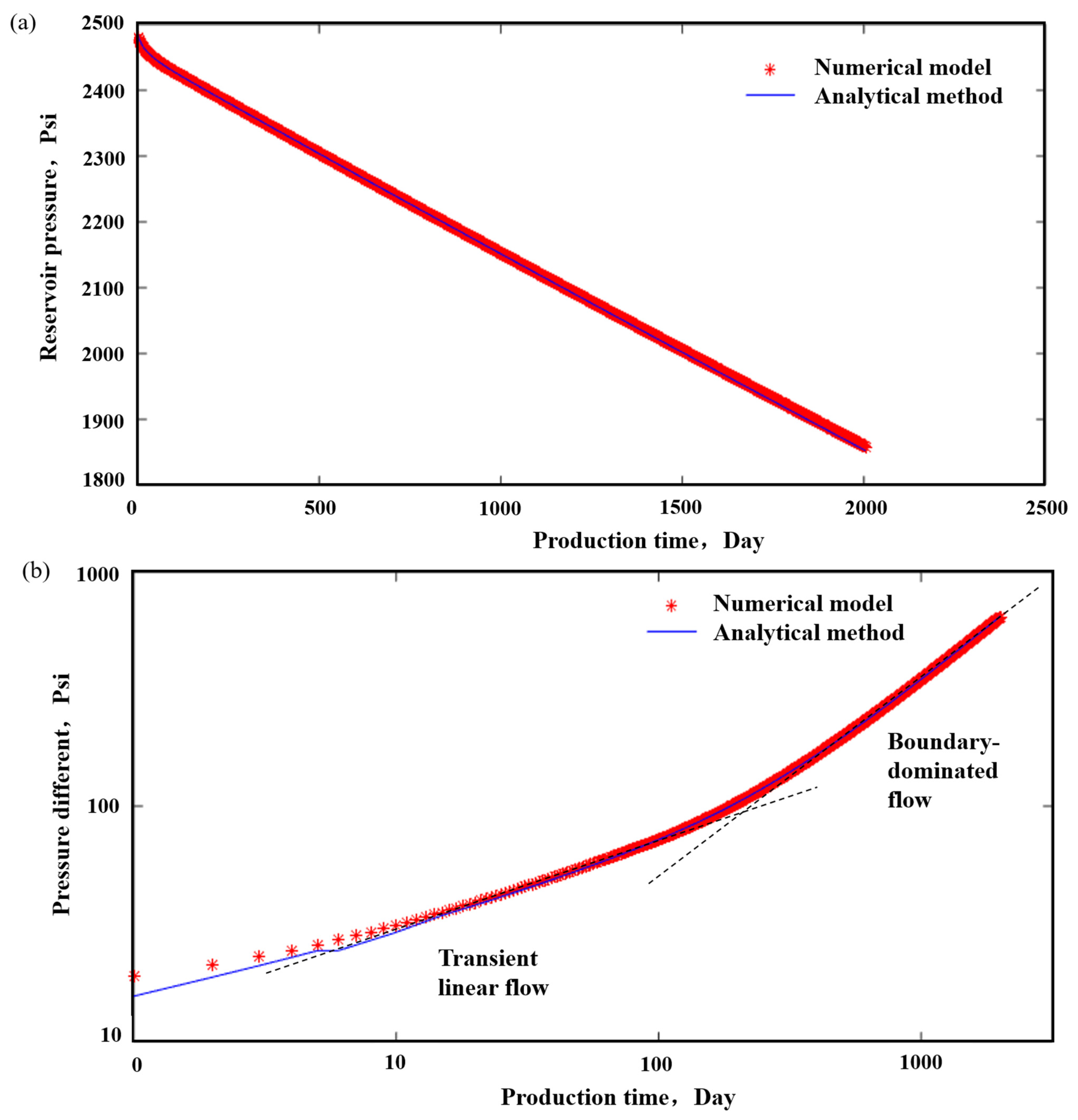
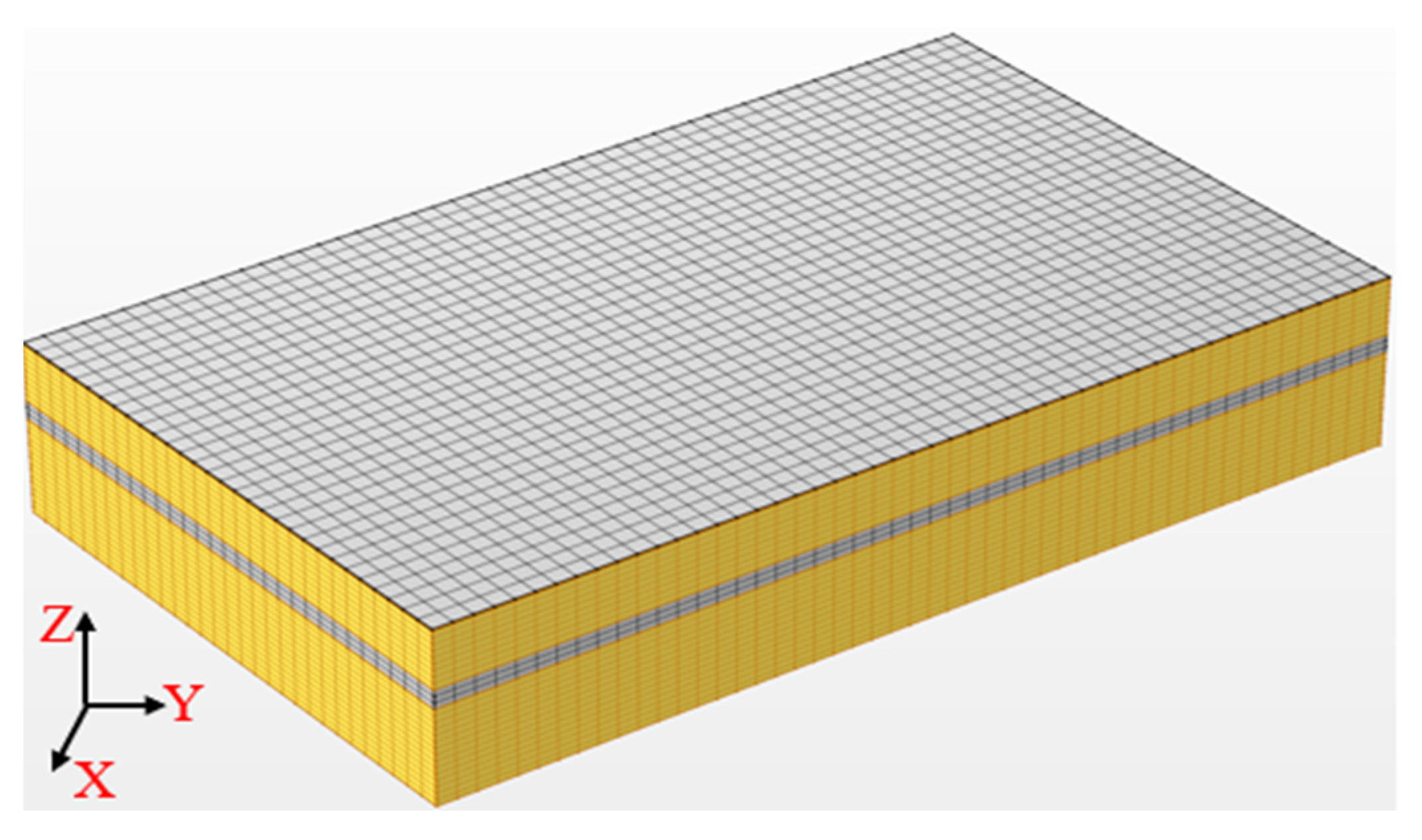
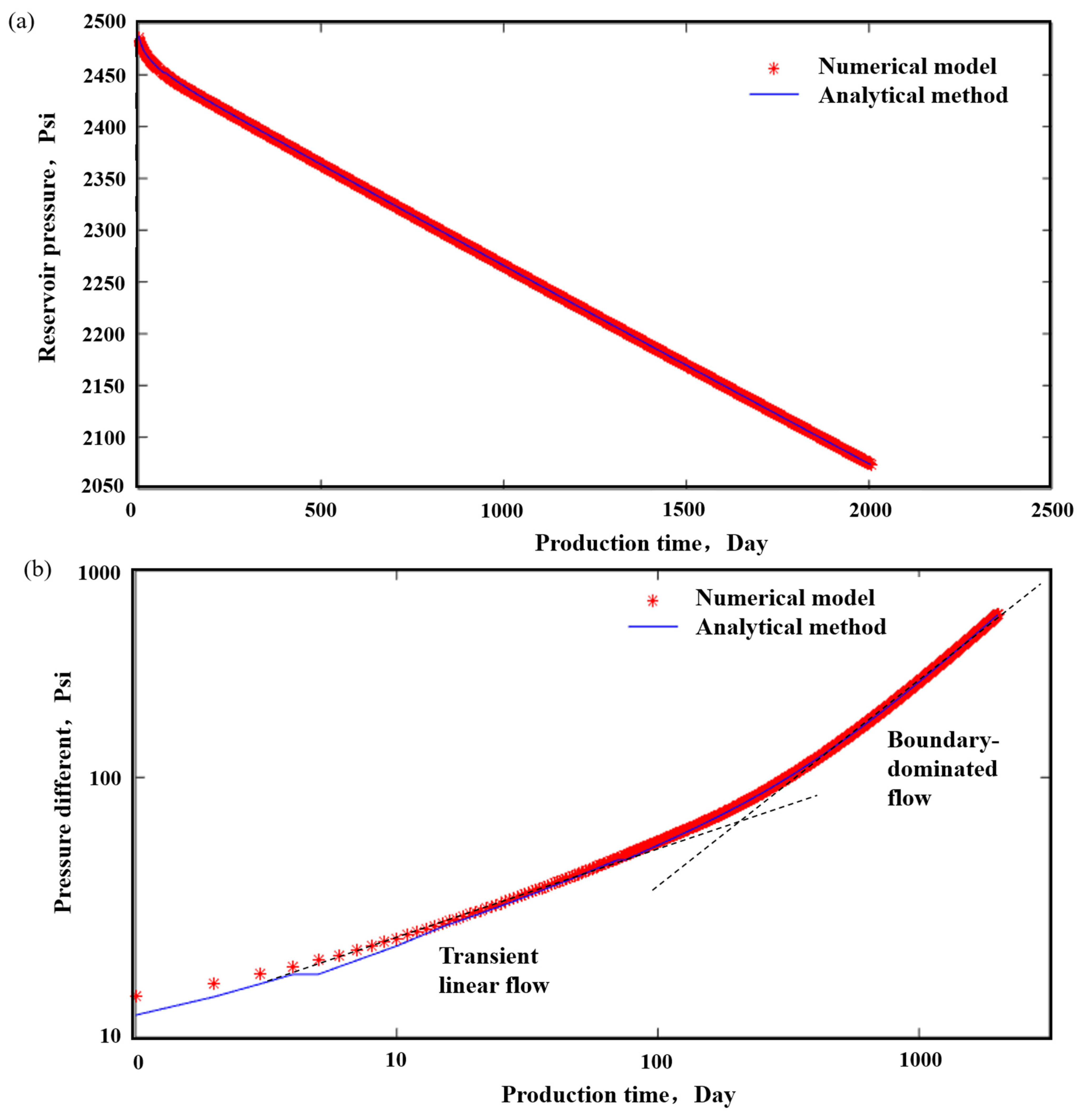

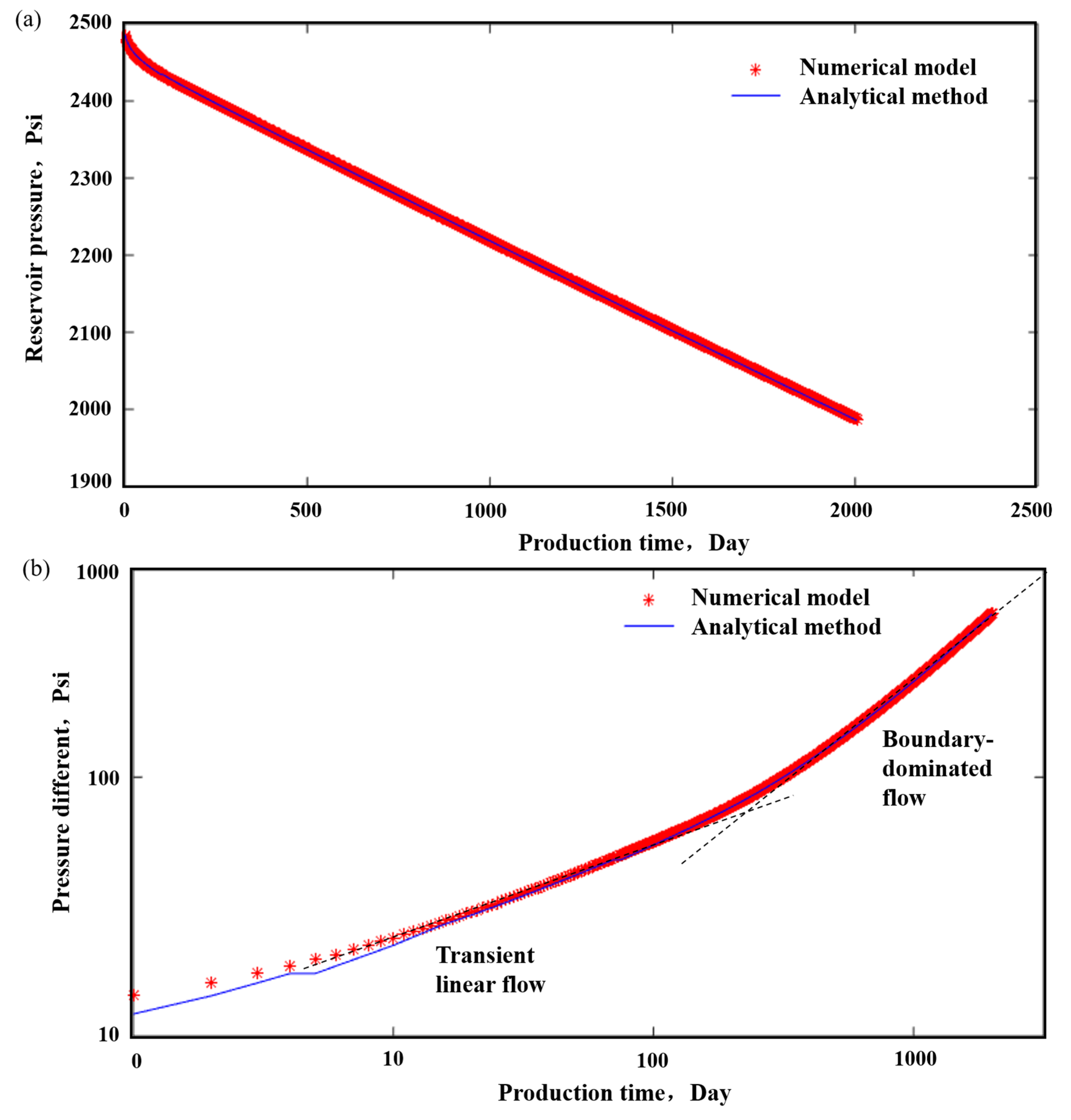

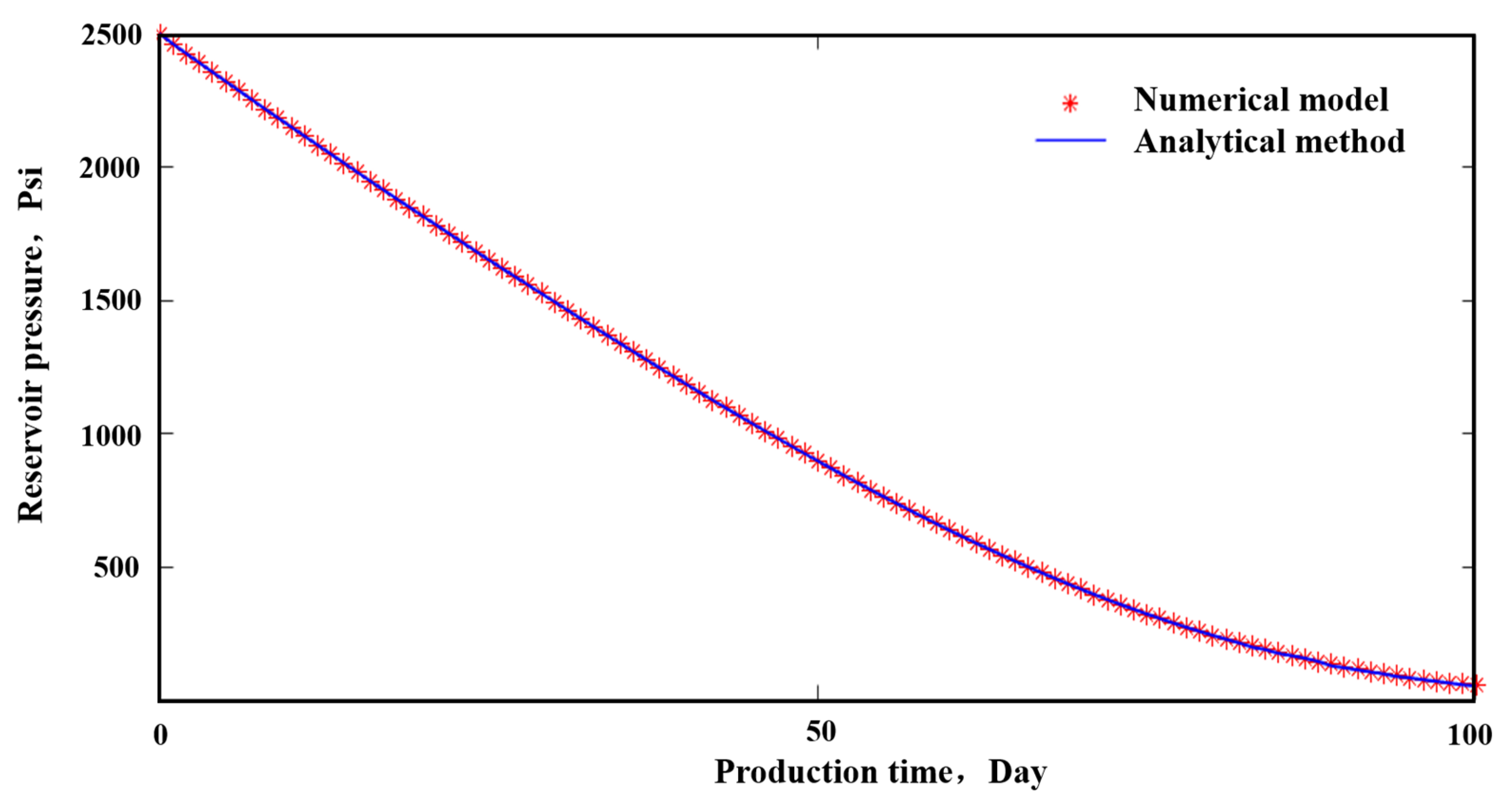
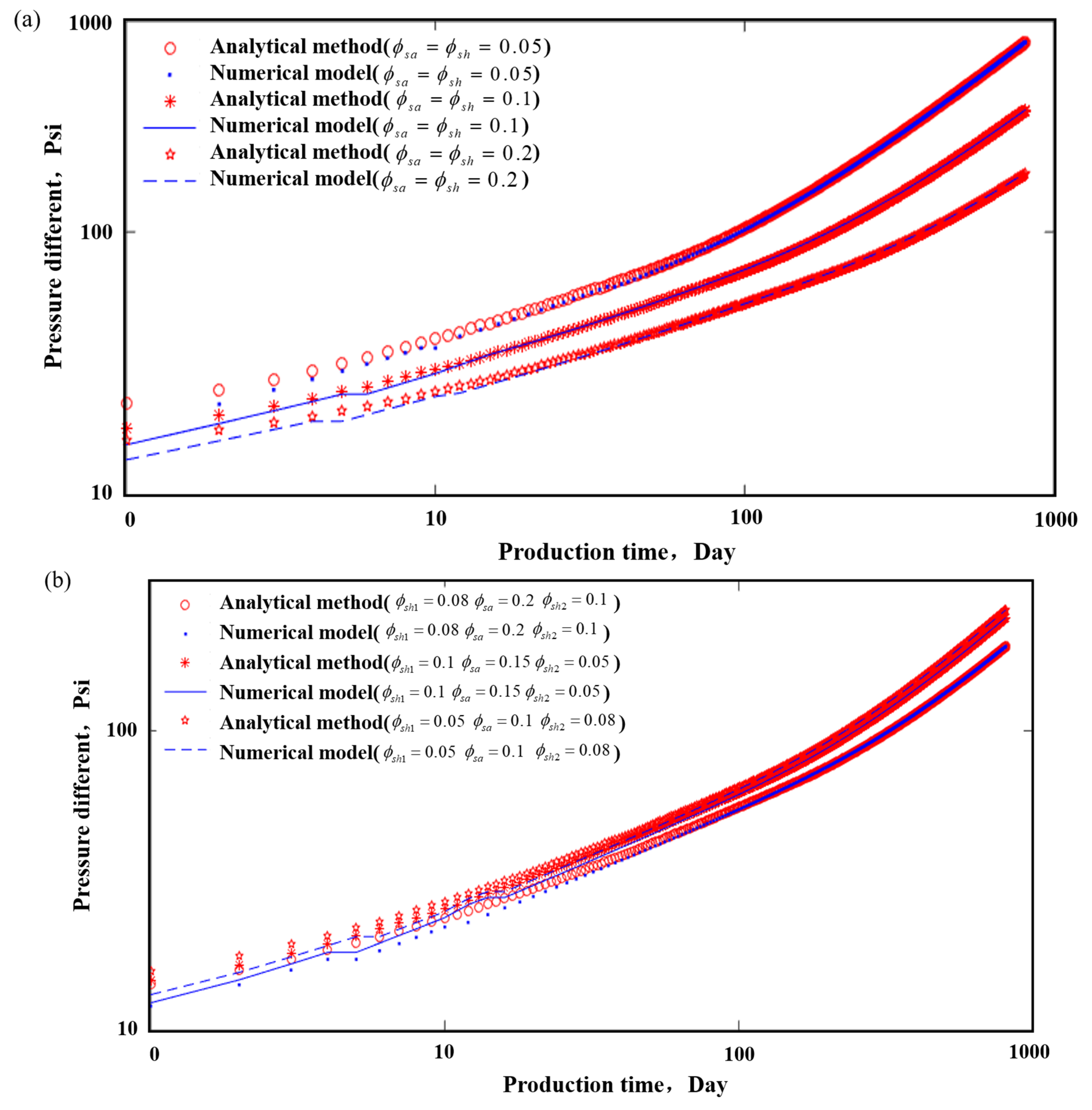
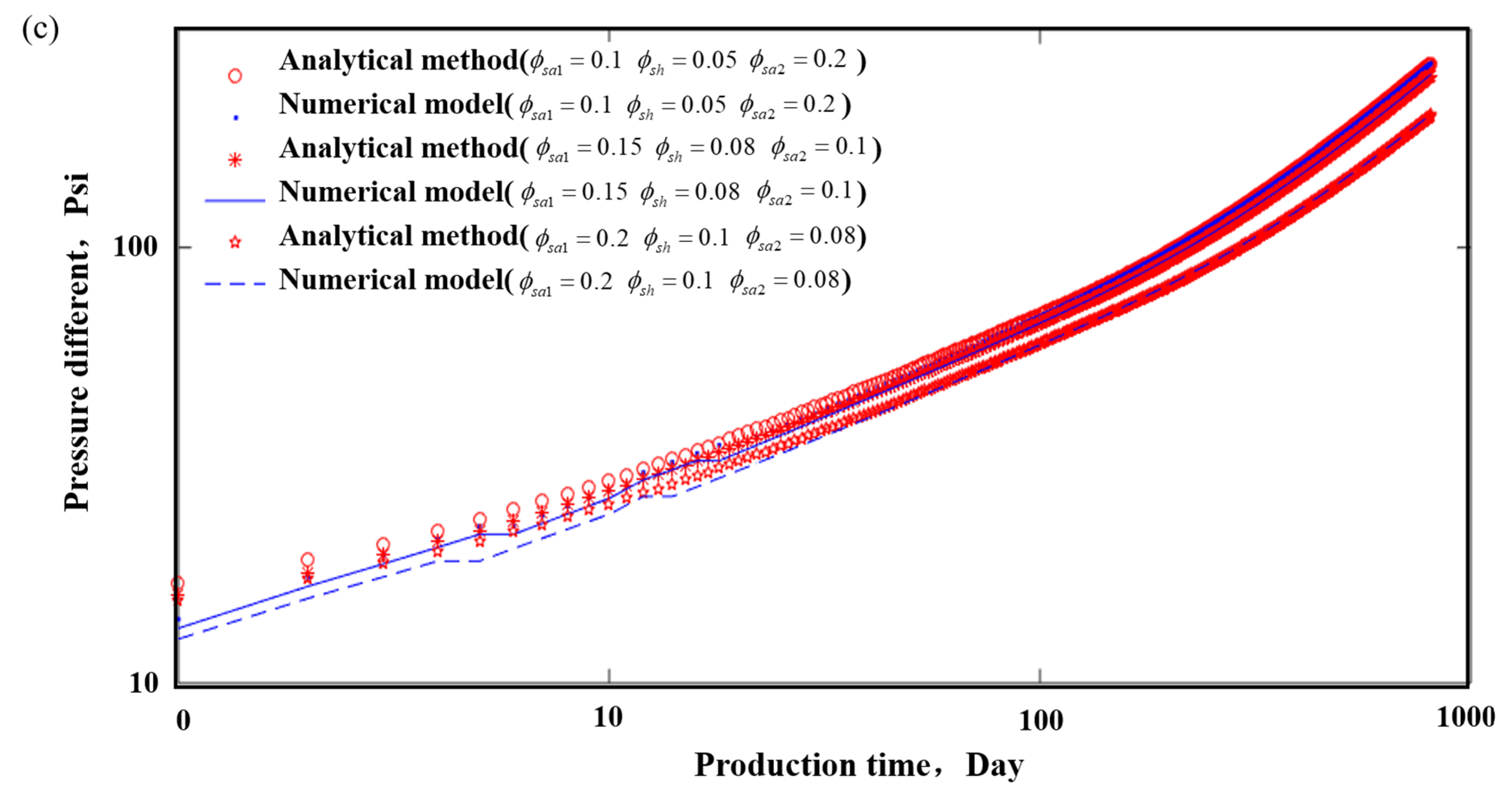
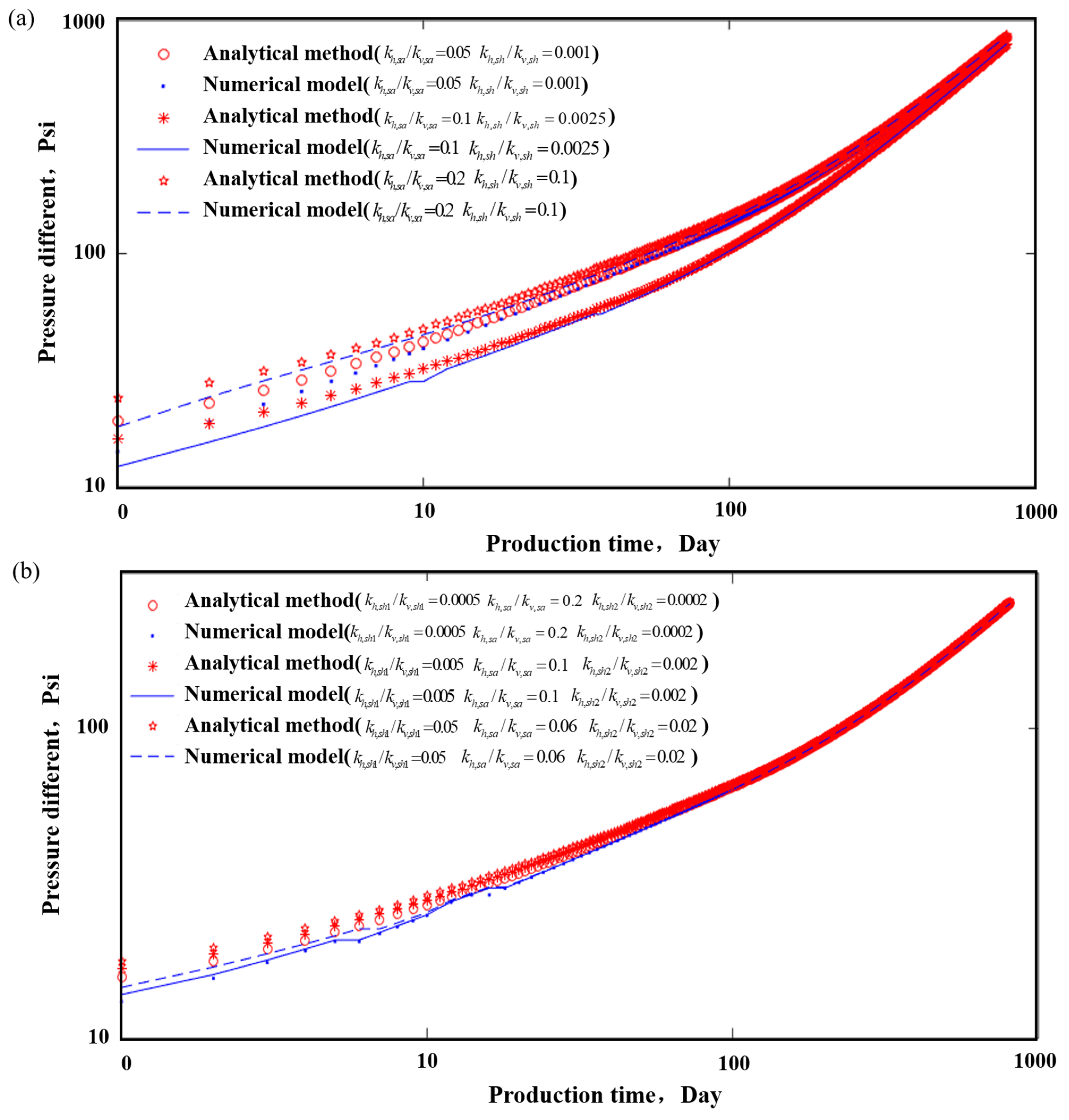
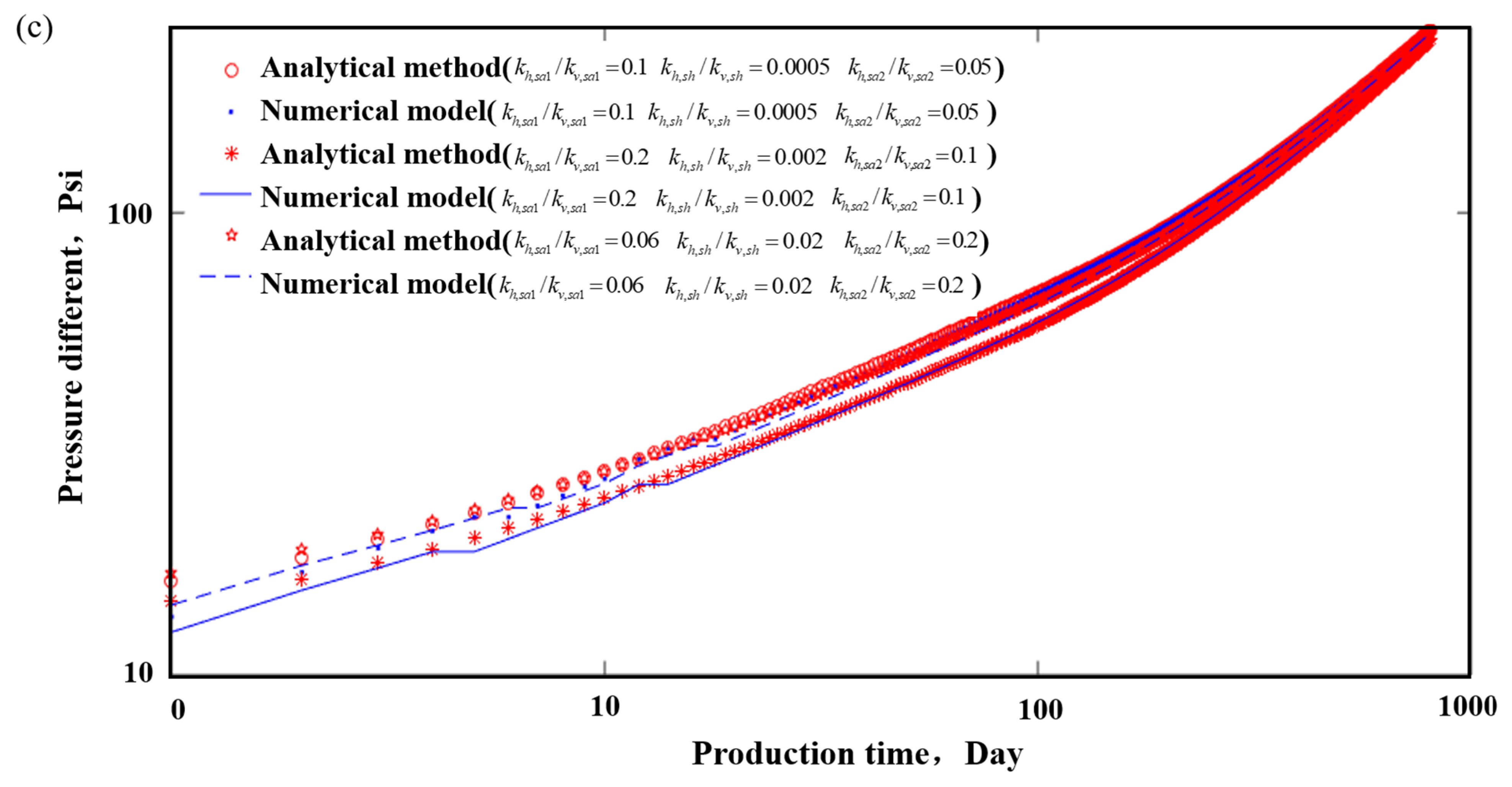
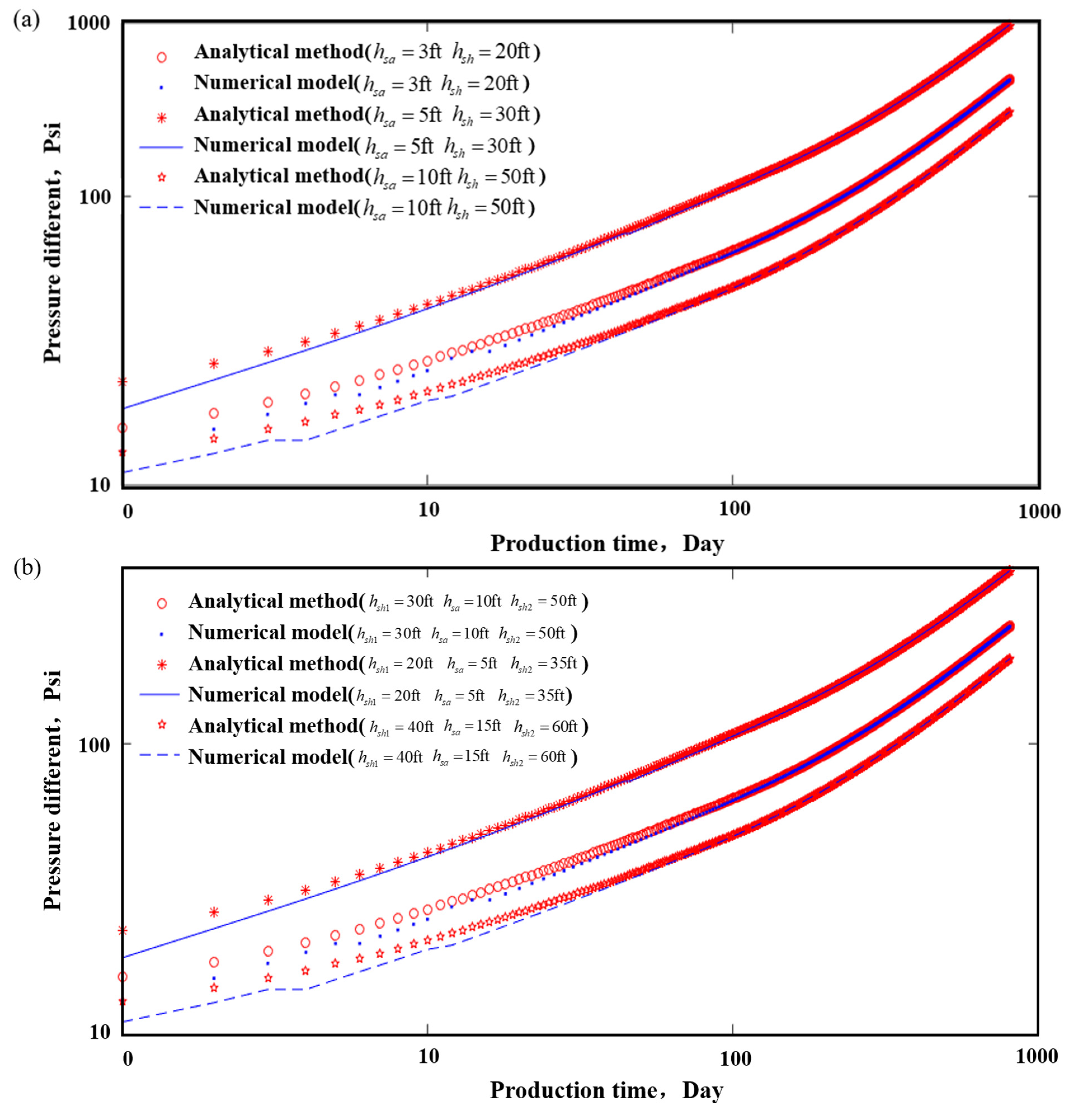
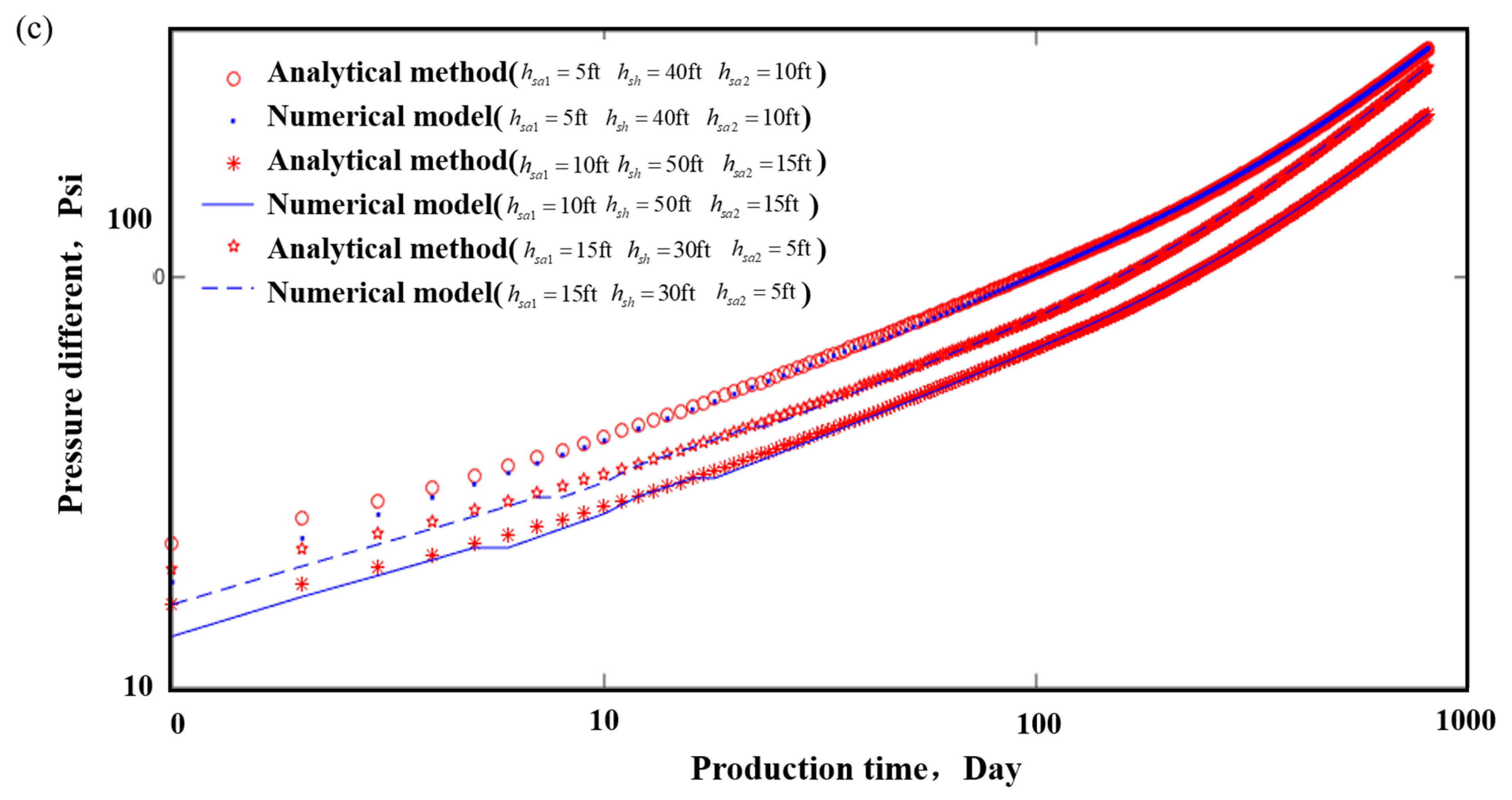
| Parameters | Value | Parameters | Value |
|---|---|---|---|
| Number of model grids | 21 × 51 × 2 | Initial Pressure (Psi) | 2500 |
| Model dimension (ft × ft × ft) | 300 × 500 × 60 | Porosity | 0.1 |
| Temperature (K) | 318.15 | Fracture permeability (mD) | 500 |
| Langmuir pressure (Psi) | 650 | Langmuir volume (Mscf/ton) | 0.096 |
| Case 1 | |||
| Parameters | Shale Layer | Sandstone Layer | |
| Horizontal permeability (mD) | 0.0005 | 0.2 | |
| Vertical permeability (mD) | 1 | 1 | |
| Thickness (ft) | 50 | 10 | |
| Compressibility (Psi−1) | 7.5 × 10−6 | 1.1 × 10−5 | |
| Case 2 | |||
| Parameters | Shale Layer 1 | Sandstone Layer | Shale Layer 2 |
| Permeability (mD) | 0.2 | 0.2 | 0.0002 |
| Vertical permeability (mD) | 1 | 1 | 1 |
| Thickness (ft) | 30 | 10 | 50 |
| Compressibility (Psi−1) | 7.5 × 10−6 | 1.1 × 10−5 | 7 × 10−6 |
| Case 3 | |||
| Parameters | Sandstone layer 1 | Shale layer | Sandstone layer 2 |
| Permeability (mD) | 0.1 | 0.0005 | 0.05 |
| Vertical permeability (mD) | 1 | 1 | 1 |
| Thickness (ft) | 10 | 50 | 15 |
| Compressibility (Psi−1) | 1.1 × 10−5 | 7.1 × 10−6 | 1.5 × 10−5 |
Disclaimer/Publisher’s Note: The statements, opinions and data contained in all publications are solely those of the individual author(s) and contributor(s) and not of MDPI and/or the editor(s). MDPI and/or the editor(s) disclaim responsibility for any injury to people or property resulting from any ideas, methods, instructions or products referred to in the content. |
© 2024 by the authors. Licensee MDPI, Basel, Switzerland. This article is an open access article distributed under the terms and conditions of the Creative Commons Attribution (CC BY) license (https://creativecommons.org/licenses/by/4.0/).
Share and Cite
Wei, S.; Qiu, K. Pressure Analysis of Onshore and Offshore Shale Gas Reservoirs under Constant-Rate Condition Considering Thin Sandstone Layer and Interlayer Cross-Flow. J. Mar. Sci. Eng. 2024, 12, 457. https://doi.org/10.3390/jmse12030457
Wei S, Qiu K. Pressure Analysis of Onshore and Offshore Shale Gas Reservoirs under Constant-Rate Condition Considering Thin Sandstone Layer and Interlayer Cross-Flow. Journal of Marine Science and Engineering. 2024; 12(3):457. https://doi.org/10.3390/jmse12030457
Chicago/Turabian StyleWei, Shiming, and Kaixuan Qiu. 2024. "Pressure Analysis of Onshore and Offshore Shale Gas Reservoirs under Constant-Rate Condition Considering Thin Sandstone Layer and Interlayer Cross-Flow" Journal of Marine Science and Engineering 12, no. 3: 457. https://doi.org/10.3390/jmse12030457
APA StyleWei, S., & Qiu, K. (2024). Pressure Analysis of Onshore and Offshore Shale Gas Reservoirs under Constant-Rate Condition Considering Thin Sandstone Layer and Interlayer Cross-Flow. Journal of Marine Science and Engineering, 12(3), 457. https://doi.org/10.3390/jmse12030457





